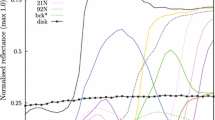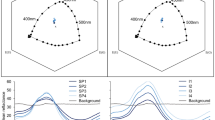Abstract
Variability in flower colour of animal-pollinated plants is common and caused, inter alia, by inter-individual differences in pigment concentrations. If and how pollinators, especially bees, respond to these small differences in pigment concentration is not known, but it is likely that flower colour variability impacts the choice behaviour of all flower visitors that exhibit innate and learned colour preferences. In behavioural experiments, we simulated varying pigment concentrations and studied its impact on the colour choices of bumblebees and honeybees. Individual bees were trained to artificial flowers having a specific concentration of a pigment, i.e. Acridine Orange or Aniline Blue, and then given the simultaneous choice between three test colours including the training colour, one colour of lower and one colour of higher pigment concentration. For each pigment, two set-ups were provided, covering the range of low to middle and the range of middle to high pigment concentrations. Despite the small bee-subjective perceptual contrasts between the tested stimuli and regardless of training towards medium concentrations, bees preferred neither the training stimuli nor the stimuli offering the highest pigment concentration but more often chose those stimuli offering the highest spectral purity and the highest chromatic contrast against the background. Overall, this study suggests that bees choose an intermediate pigment concentration due to its optimal conspicuousness. It is concluded that the spontaneous preferences of bees for flower colours of high spectral purity might exert selective pressure on the evolution of floral colours and of flower pigmentation.



Similar content being viewed by others
References
Armbruster WS, Antonsen L, Pélabon C (2005) Phenotypic selection on Dalechampia blossoms: honest signaling affects pollination success. Ecology 86:3323–3333. doi:10.1890/04-1873
Asmussen CB (1993) Pollination biology of the Sea Pea, Lathyrus japonicus: floral characters and activity and flight patterns of bumblebees. Flora 188:227–237
Avarguès-Weber A, de Brito Sanchez MG, Giurfa M, Dyer AG (2010) Aversive reinforcement improves visual discrimination learning in free-flying honeybees. PLoS One 5:e15370. doi:10.1371/journal.pone.0015370
Backhaus W (1992) The Bezold–Brücke effect in the color vision system of the honeybee. Vision Res 32:1425–1431
Belsare PV, Sriram B, Watve MG (2009) The co-optimization of floral display and nectar reward. J Biosci 34:963–967. doi:10.1007/s12038-009-0110-7
Benard J, Giurfa M (2008) The cognitive implications of asymmetric color generalization in honeybees. Anim Cogn 11:283–293
Benjamini Y, Hochberg Y (1995) Controlling the false discovery rate: a practical and powerful approach to multiple testing. J Roy Stat Soc B Met 57:289–300
Brandt R, Vorobyev M (1997) Metric analysis of threshold spectral sensitivity in the honeybee. Vision Res 37:425–439
Schemske DW, Bradshaw HD Jr (1999) Pollinator preference and the evolution of floral traits in monkeyflowers (Mimulus). Proc Natl Acad Sci USA 96:11910–11915. doi:10.1073/pnas.96.21.11910
Chittka L (1992) The colour hexagon: a chromaticity diagram based on photoreceptor excitations as a generalized representation of colour opponency. J Comp Physiol A 170:533–545
Chittka L, Thomson JD, Waser NM (1999) Flower constancy, insect psychology, and plant evolution. Naturwissenschaften 86:361–377
Cittka L, Kevan PG (2005) Advertisement in flowers. In: Dafni A, Kevan PG, Husband BC (eds) Practical pollination biology. Enviroquest Ltd., Cambridge, pp 147–230
Dobson HEM, Danielson EM, Wesep IDV (1999) Pollen odor chemicals as modulators of bumble bee foraging on Rosa rugosa Thunb. (Rosaceae). Plant Spec Biol 14:153–166
Dyer AG, Chittka L (2004a) Fine colour discrimination requires differential conditioning in bumblebees. Naturwissenschaften 91:224–227
Dyer AG, Chittka L (2004b) Biological significance of distinguishing between similar colours in spectrally variable illumination: bumblebees (Bombus terrestris) as a case study. J Comp Physiol A 190:105–114
Dyer AG, Neumeyer C (2005) Simultaneous and successive colour discrimination in the honeybee (Apis mellifera). J Comp Physiol A 191:547–557
Dyer AG, Spaethe J, Prack S (2008) Comparative psychophysics of bumblebee and honeybee colour discrimination and object detection. J Comp Physiol A 194:617–627
Endler JA (1990) On the measurement and classification of colour in studies of animal colour patterns. Biol J Linn Soc 41:315–352. doi:10.1111/j.1095-8312.1990.tb00839.x
Exner F, Exner S (1910) Die physikalischen Grundlagen der Blütenfärbungen. Sitz der Akad Wiss Wien math naturw. Klasse 119(Abt 1):1–55
Giurfa M, Núñez J, Chittka L, Menzel R (1995) Colour preferences of flower-naive honeybees. J Comp Physiol A 177:247–259
Giurfa M, Vorobyev M, Kevan P, Menzel R (1996) Detection of coloured stimuli by honeybees: minimum visual angles and receptor specific contrast. J Comp Physiol A 178:699–709
Giurfa M, Vorobyev M, Brandt R, Posner B, Menzel R (1997) Discrimination of coloured stimuli by honeybees: alternative use of achromatic and chromatic signals. J Comp Physiol A 180:235–243
Giurfa M, Vorobyev M (1998) The angular range of achromatic target detection by honey bees. J Comp Physiol A 183:101–110
Giurfa M (2004) Conditioning procedure and color discrimination in the honeybee Apis mellifera. Naturwissenschaften 91:228–231
Goulson D, Cruise JL, Sparrow KR, Harris AJ, Park KJ, Tinsley MC, Gilburn AS (2007) Choosing rewarding flowers; perceptual limitations and innate preferences influence decision making in bumblebees and honeybees. Behav Ecol Sociobiol 61:1523–1529
Gumbert A (2000) Color choices by bumble bees (Bombus terrestris) innate preferences and generalization after learning. Behav Ecol Sociobiol 48:36–43
Hempel de Ibarra N, Giurfa M, Vorobyev M (2001) Detection of coloured patterns by honeybees through chromatic and achromatic cues. J Comp Physiol A 187:215–224
Hempel de Ibarra N, Giurfa M, Vorobyev M (2002) Discrimination of coloured patterns by honeybees through chromatic and achromatic cues. J Comp Physiol A 188:503–512
Hill PSM, Wells PH, Wells H (1997) Spontaneous flower constancy and learning in honey bees as a function of colour. Anim Behav 54:615–627
Kay QON, Daoud HS, Stirton CH (1981) Pigment distribution, light reflection and cell structure in petals. Bot J Linn Soc 83:57–83. doi:10.1111/j.1095-8339.1981.tb00129.x
Kevan PG, Giurfa M, Chittka L (1996) Why are there so many and so few white flowers? Trends Plant Sci 1:280–284
Kugler H (1936) Blütenökologische Untersuchungen mit Hummeln VIII. Planta 25:346–363
Laughlin SB (1981) Neural principles in the peripheral visual systems of invertebrates. In: Autrum H (ed) Vision in invertebrates (Handbook of sensory physiology). Springer, Berlin, pp 133–280
Lunau K (1990) Color saturation triggers innate reactions to flower signals—flower dummy experiments with bumblebees. J Comp Physiol A 166:827–834
Lunau K (1996) Unidirectionality of floral colour change. Plant Syst Evol 200:125–140
Lunau K, Wacht S, Chittka L (1996) Colour choices of naive bumble bees and their implications for colour perception. J Comp Physiol A 178:477–489
Lunau K, Papiorek S, Eltz T, Sazima M (2011) Avoidance of achromatic colours by bees provides a private niche for hummingbirds. J Exp Biol 214:1607–1612. doi:10.1242/jeb.052688
Matsumura S, Yokoyama J, Tateishi Y, Maki M (2006) Intraspecific variation of flower colour and its distribution within a sea lavender, Limonium wrightii (Plumbaginaceae), in the northwestern Pacific Islands. J Plant Res 119:625–632
Meléndez-Ackerman E, Campbell DR, Waser NM (1997) Hummingbird behavior and mechanisms of selection on flower color in Ipomopsis. Ecology 78:2532–2541. doi:10.1890/0012-9658(1997) 078
Menzel R, Backhaus W (1991) Color vision in insects. In: Gouras P (ed) Vision and visual dysfunction. VI. Perception of color. Macmillan, Houndmills, pp 262–293
Menzel R, Shmida A (1993) The ecology of flower colours and the natural colour vision of insect pollinators: the Israeli flora as a study case. Biol Rev 68:81–120. doi:10.1111/j.1469-185X.1993.tb00732.x
Neumeyer C (1981) Chromatic adaptation in the honeybee: successive color contrast and color constancy. J Comp Physiol 144:543–553
Noda K-I, Glover BJ, Linstead P, Martin C (1994) Flower colour intensity depends on specialized cell shape controlled by a Myb-related transcription factor. Nature 369:661–664. doi:10.1038/369661a0
R Development Core Team (2008) R: a language and environment for statistical computing. R Foundation for Statistical Computing, Vienna, http://www.R-project.org. ISBN 3-900051-07-0
Raine NE, Ings TC, Dornhaus A, Saleh N, Chittka L (2006) Adaptation, genetic drift, pleiotropy, and history in the evolution of bee foraging behavior. Adv Stud Behav 36:305–354
Rohde K, Papiorek S, Lunau K (2013) Bumblebees (Bombus terrestris) and honeybees (Apis mellifera) prefer similar colours of higher spectral purity over trained colours. J Comp Physiol A 199:197–210. doi:10.1007/s00359-012-0783-5
Schaefer HM, Schaefer V, Levey DJ (2004) How plant-animal interactions signal new insights in communication. Trends Ecol Evol 19:577–584
Schaefer HM, Spitzer K, Bairlein F (2008) Long-term effects of previous experience determine nutrient discrimination abilities in birds. Front Zool 5:4. doi:10.1186/1742-9994-5-4
Shipunov A, Kosenko Y, Volkova P (2011) Floral polymorphism in common primrose (Primula vulgaris Huds., Primulaceae) of the Northeastern Black Sea coast. Plant Syst Evol 296:167–178
Skorupski P, Döring TF, Chittka L (2007) Photoreceptor spectral sensitivity in island and mainland populations of the bumblebee, Bombus terrestris. J Comp Physiol A 193:485–494
Skorupski P, Chittka L (2010) Photoreceptor spectral sensitivity in the bumblebee, Bombus impatiens (Hymenoptera: Apidae). PLoS One 5:e12049. doi:10.1371/journal.pone.0012049
Sprengel CK (1793) Das entdeckte Geheimnis der Natur im Bau und in der Befruchtung der Blumen. Fascimile-Druck. Mayer & Müller, Berlin
Tastard E, Andalo C, Giurfa M, Burrus M, Thébaud C (2008) Flower colour variation across a hybrid zone in Antirrhinum as perceived by bumblebee pollinators. Arthropod-Plant Inter 2:237–246. doi:10.1007/s11829-008-9046-3
Tourjee KR, Harding J, Byrne TG (1993) Calorimetric analysis of Gerbera flowers. HortSci 28:735–737
Vogel S (1949) Farbwechsel und Zeichnungsmuster bei Blüten. Plant Syst Evol 97:44–100
Vorobyev M, Osorio D (1998) Receptor noise as a determinant of colour thresholds. Proc R Soc Lond B 265:351–358. doi:10.1098/rspb.1998.0302
Vorobyev M, Brandt R, Peitsch D, Laughlin SB, Menzel R (2001) Colour thresholds and receptor noise: behaviour and physiology compared. Vision Res 41:639–653
Weiss MR (1991) Floral color changes as cues for pollinators. Acta Hort 288:294–298
Whibley AC, Langlade NB, Andalo C, Hanna AI, Bangham A, Thebaud C, Coen E (2006) Evolutionary paths underlying flower color variation in Antirrhinum. Science 313:963–966
Wyszecki G, Stiles WS (1982) Color science: concepts and methods, quantitative data and formulae. Wiley, New York
Acknowledgements
We thank Robert Junker for critical comments on the manuscript and statistical improvement, Ann Thorson for linguistic improvement and the E-Norm graduate school for funding.
Author information
Authors and Affiliations
Corresponding author
Additional information
Communicated by: Sven Thatje
Rights and permissions
About this article
Cite this article
Papiorek, S., Rohde, K. & Lunau, K. Bees’ subtle colour preferences: how bees respond to small changes in pigment concentration. Naturwissenschaften 100, 633–643 (2013). https://doi.org/10.1007/s00114-013-1060-3
Received:
Revised:
Accepted:
Published:
Issue Date:
DOI: https://doi.org/10.1007/s00114-013-1060-3




